Fill’er up! Texaco Tanker Truck
The 1917 photo below is the Reed Brothers original Rockville Garage located at the intersection of Veirs Mill Road and Rockville Pike. To the right is a Texaco Gasoline Filling Station sign. One very tall Texaco branded fuel pump can be seen in this photo along with two Texaco Petroleum refueling trucks. The gas pump globe on the top advertises the gas company name and logo. Parked in front is a line-up of some very early Dodge Brothers Motor Vehicles.
Note the unpaved dirt road on Rockville Pike and trolley tracks running past the dealership. From 1900-1935, the trolley cars went past Reed Brothers Dodge as they traveled up Rockville Pike. Major stops along the line included Georgetown, Alta Vista, Bethesda, Montrose, Halpine, the Fairgrounds, Courthouse Square, and Chestnut Lodge.

1917 Original Rockville Garage with 2 story addition. Note the Texaco Filling Station signage and the Texaco Petroleum fuel truck refilling the single pump in front. Photo by Lewis Reed
At some point between prior to 1920, Reed Brothers Dodge changed over from selling Texaco and became a Gulf Gasoline dealer. Reed Brothers had the first Gulf gas station in the still-rural Washington D.C. area. (click on images to enlarge)
A Texaco Petroleum Truck sits in front of Rockville Garage after delivering its load of fuel. On the side of the tanker is a hinged wooden box carrying 2-drums of a Texaco product. The delivery driver seems to be wearing his best suit on this job, something that you don’t see these days at all.
In addition to Texaco gasoline, Rockville Garage also carried a full line of Texaco lubricants, Fisk tires, Willard batteries and many other well known brands of merchandise.
The most essential vehicle of the early 20th century had to have been the tanker truck. In the pioneering period of tanker trucks, 1910 to 1920, the Texas Company was among many that were fitted with tanks to carry refined products such as gasoline, kerosene and fuel oil.
Reed Photo Collection: Early 20th Century Motorcycles
Motorcycles have evolved in countless ways since their emergence near the beginning of the 20th century. In the early years of the 20th century, motorcycles and automobiles were competing for the same audience. Most people traveled either on or behind a horse, while the more adventurous were fascinated by those new-fangled bicycle things. So anything with a motor represented a giant step forward.
Take a step back in time with this glimpse into an almost forgotten era of Montgomery County history in the early 20th century… the motorcycle era. These photographs taken by Lewis Reed span a period from roughly the early 1900s up until about the late 1920s.
Lewis Reed was not only passionate about automobiles, he also enjoyed riding motorcycles. At the turn of the century, before cars were even around, Lewis Reed traveled up and down the East Coast on his motorcycle with his brother, Edgar, and a group of friends. In the early days of motorcycling, propriety dictated that a gentleman be presentable when he went out for a spin, and since tweed suits were the standard countryside uniform of the the late-nineteenth century, so it was for motorcyclists as well. Jodhpurs and full-length boots derived from horseback riding and jackets with a cut consistent with hunting and other kinds of sports were adapted to the new pursuit of motorcycle riding.
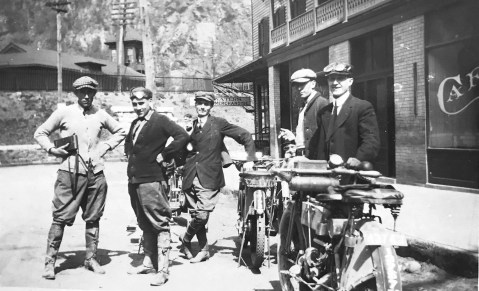
Above, Lewis Reed stands with his camera at far left. The photo was taken 1914 in Harper’s Ferry, West Virginia. The wooden frame Victorian-style train station dating from 1889 can be seen in the background.
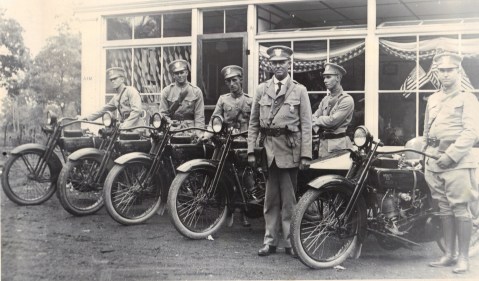
This photograph is the first known photograph of the entire Montgomery County Police Force. Photo taken by Lewis Reed on July 4, 1922.
Montgomery County Mounted Police
By the early 1920’s, the motorcycle had proven itself to be a rugged, reliable, and economical means of transportation. No one benefited from this more than law enforcement agencies. State and local police departments quickly adopted the new machines into their arsenal, allowing patrolmen to more skillfully navigate city streets and venture farther into rural areas.
Posing in front of Reed Brothers Dodge on July 4, 1922 Chief Charles Cooley, center, and his men of the first mounted unit of the Montgomery County Police Force, were on their first day of duty. For several years, since there was no police station, the officers would meet for “roll call” on the steps of the Red Brick Courthouse in Rockville at 2:00 p.m. every day to let each other know they were alive and well. Chief Cooley was given the privilege of a Model T Ford. The chief was paid $1,800 a year (the chief now gets $112,564) while the officers got $1,500. Each of the officers was issued a Harley-Davidson motorcycle, a .38 Smith & Wesson handgun, a black jack, law book and was allotted $300.00 a year for the upkeep of their motorcycle.
Have you ever come across a picture that you had to look at twice just to make sure you were not crazy? Well I have… and the photo above is one of them. When I came across this photograph in Lewis Reed’s album, I had to look at it several times to make sure I was not “seeing things”. There is something surprising in this photograph, and when I finally figured out what it was, it put a big smile on my face.
Can you spot the unusual object in this photo?
OK, give up?
Once motorcycles were established in the marketplace, various accessory items were developed to accommodate a larger audience for the product. The sidecar, a one-wheeled passenger compartment that was attached to the main frame of the motorcycle, was perhaps the most visible accessory. The sidecar expanded the number of passengers that could be driven and also improved the stability of the vehicle.
This is a photograph taken by Lewis Reed of an Indian motorcycle with his brother, Edgar, seated in the sidecar. From what I’ve been able to research, I believe it’s a 1914 Indian. The handle bars on a 1913 had no cross bar, the 1914 model had a cross bar that can be seen on this one. The tool box was mounted on the rear of the carrier in 1913 and moved to the top of the fuel tank in 1914.
Riders wore gauntlet gloves along with their full-length boots to keep the wind out, as well as provide a little extra skin protection should they go down. A less protective addition to the motorcycling wardrobe was the flat cap.

A motorcycle racer rips down an unknown racetrack kicking up dust in his wake. Photo by Lewis Reed, ca. 1915
Lewis Reed Captures the Thrill of Motorcycle Racing in 1915
In the first years of the twentieth century, companies like Harley-Davidson and Indian began producing motorcycles for the general public. Although there is not an exact date of the first motorcycle race, you can be sure that as soon as there were two motorcycles on the road, there was racing. As more and more motorcycle manufactures started popping up across the U.S., motorcycle racing started making it’s way to more official venues. The earliest races were held on fairground dirt tracks used for horse racing. On short tracks, typical of county fairs, the most valuable driving technique involved the infamous “pendulum skid,” with riders taking the curves much as automobile drifters do today (but with two wheels fewer, to add to the excitement).
The photograph above taken by Lewis Reed shows an unknown racer at a fairground raceway in the early 1900s. In the teens, motorcycle racing on dirt tracks throughout the country, was one of the most popular spectator sports. Despite the danger to both racers and spectators, the motorcycle races became very popular and drew large crowds of spectators. Motorcycle racing continued until just after World War 1, when the focus shifted to automobile racing.
Back in the early part of the last century when the motorcycle was still new and a novelty, it was often used for Kodak moments. In the photo above, the toddler’s sporty little cap and goggles make the image. Just imagine how excited she must have been to sit on that big machine. The motorcycle seems to be well equipped with extras including: a headlamp, a handlebar-mounted Klaxon horn, and a well padded passenger seat on the back.

Motorcyclists in front of Greenawalt Drug Store in Frederick, Maryland. Photo by Lewis Reed, circa 1915
Things look pretty quiet in front of Greenawalt Drug Store on Market Street in Frederick, Maryland on this day some 100 years ago. In the early days, motorcyclists were more likely to wear a tie and sporty little cap than the leather of today.
Motorcycle repair shops were nearly nonexistent in the early 1900s, so many motorcyclists had to learn to fix their own machines wherever they broke down. Early motorcycles carried a tool box mounted on the rear luggage carrier, or on the top of the fuel tank. Hand air pumps were also carried in case the rider had a flat tire along the way.
If you look closely at this photo, you can see bicycle pedals on the motorcycle. Most early motorcycles were equipped with pedals so that an unlucky rider with a failed engine could still get home. They were also handy for getting a little extra uphill push and for starting the machine.
The early days of motorcycle riding was an expensive joy and pursued mostly by wealthy men. Instead of having a motorcycle as a source of transportation, gentlemen of the days oftentimes used it to spice up their sunny weekends and impress ladies. Outfit relevance dictated a gentleman to be presentable and neat, so when going for a spin, Edgar Reed is wearing a leather jacket, full-length boots, necktie and sporty cap with goggles.

Edgar Reed (rider second from left) and Lewis Reed standing behind him (others unidentified). On Park Street in Rockville, ca. 1912
Early motorcyclists were often pictured in riding groups. From its beginnings, motorcycling developed very much as a social activity. Lewis and Edgar Reed, along with brother-in-law Bernard Hanshew, began their riding adventures with a group of friends from the Park Avenue community in Rockville in the early 1900s.

Eleanora Reed, and Lewis Reed’s sisters Geneva and Eva posing on Excelsior motorcycles, 1912. (Note they are all sitting “side-saddle” as true ladies of the time would have been expected to do). Photo by Lewis Reed
While women have been enthusiastic bikers ever since motorcycles were invented, they have had to push back against deeply ingrained attitudes. Women in the first half of the 20th century were expected to dress fashionably and conservatively, and above all, remain ladylike. Sitting astride a motorcycle was considered uncouth: the same as riding a horse with a leg on each side.
Reed Photo Collection Highlight: Early 20th Century Motorcars
Each of the images below from Lewis Reed’s Collection has a car included, whether as a center point of a family photo, in the background of life’s moments, or on a cross-country road trip. These photos give a snapshot not just of the cars at the time, but a peak into an important aspect of the everyday lives of County residents.
There were no paved highways for automobiles to shoot along at 60 and 70 miles an hour; just country roads, filled with ruts, sand, and mud, over which no one wanted to drive at the maximum speed of passenger cars, which was about 30 miles an hour. But every trip was a different adventure.

In the early 20th century, traveling cross-country by automobile was intimidating, if not a little bit dangerous. Cars were unreliable and roads were rough. The child in the photo is my mother, Mary Jane Reed Gartner. Photo by Lewis Reed
A cross-country road trip is a quintessentially American experience. It’s always an adventure, but in modern times it’s a relatively tame one: The roads are paved, signs point the way, and Siri always has your back. If cars had cup holders back then, these folks would be rolling with crystal goblets, not Big Gulps.
Come away with me, Lucille: In my merry Oldsmobile: Down the road of life we’ll fly: Automo-bubbling, you and I….

Ethelene Thomas Reed, who married Lewis Reed in 1921, is sitting in passenger seat of a circa 1918 Oldsmobile Club Roadster and her sister, Celeste Thomas Brown, is sitting behind her in the back seat. Photo by Lewis Reed

1918 Oldsmobile Roadster shown with Ethelene and her sister Celeste behind the wheel. Photo taken by Lewis Reed at the Clinton Clay Thomas family farm which was located on Butterfly Lane in Braddock, Maryland. Photo by Lewis Reed
Back in the early part of the last century when the automobile was still new and a novelty, it was often used for Kodak moments.

Two ladies posing in a 1911 Speedwell Touring car. Check out the humongous steering wheel! Photo by Lewis Reed
The photographs below was taken by Lewis Reed on one of his many cross country road trips. The car is a 1935 Dodge Touring Sedan with Maryland Dealer license plates. Note the rear-hinged “Suicide Door”. Cars of this era did not have seat belts, so there was nothing to hold a passenger in the car. The term “suicide doors” was therefore placed on vehicles with the rear-hinged door configuration, the theory being that the forward motion of the car could cause the door to fly open, possibly causing the unlucky person sitting next to the door to be pulled out of the car, or the door itself could be ripped from its hinges.
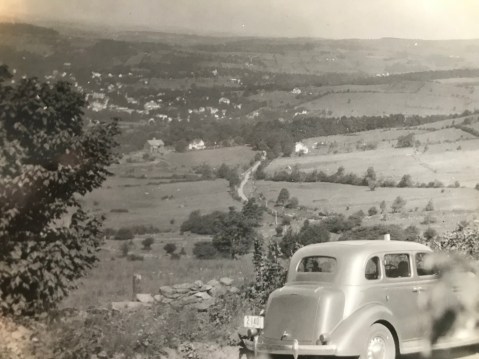
I have no idea what prompted my grandfather to take a photo at this location, but perhaps it was the amazing view in the background. Photo by Lewis Reed
In order for occupants of early 1920’s cars to remain warm during the cold winter months, especially when it was snowing, it was necessary for them to dress warmly and cover themselves with blankets. Note the car in the photo below is mostly open-bodied, with no windows and certainly no heat. Tire chains are on the rear tires. I cannot say with any certainty, but I believe it is Lewis Reed’s car with his wife and baby daughter, Mary Jane, sitting inside all bundled up.
Early motorists weren’t afraid to drive in the snow simply because they didn’t have 4-wheel drive and electronic assistance; they just got out and did it. Who would dare go out in these conditions today without an AWD SUV and heated seats?

Car stopped (stuck?) on snowbound road. Although no tire chains are in evidence, they might have been useful coming up that hill. Photo by Lewis Reed
Nobody really thinks about it today. If your car is too cold, then simply switch on the “heater” and soon your car will be warm. However, it wasn’t always that way. What passengers did back then, in the early days of motoring, was bundle up as if one was outdoors. This meant heavy clothing, winter gloves and snow boots. It wasn’t long, however, before car makers realized that a few comforts, like heat in the passenger compartment, or even some type of heated seating, would help sell cars.

Lewis Reed’s 1920 Oldsmobile stopped along Goshen Road outside rural Gaithersburg. Photo by Lewis Reed
In 1900 car owners were almost by definition wealthy, especially since they often employed chauffeurs: many wouldn’t have dreamed of trying to operate their own vehicles. The earliest car owners had no real repair business to turn to. To be a successful motorist in the early 1900s, you needed to have some sort of mechanical skills. Or you had to find someone who did. Wealthy people employed private chauffeur-mechanics to not only drive, but also maintain and repair their large, expensive automobiles — rather than learn to do it themselves. Chauffeurs would be in charge of everything to do with the owner’s motor vehicle including repairs and maintenance and cleaning this meant that early personal chauffeurs had to be skilled mechanics. Pierce-Arrow was one of the most common makers of luxury cars in the early 20th century. The price for one of these vehicles was sometimes as much as ten times the price of a standard touring car.
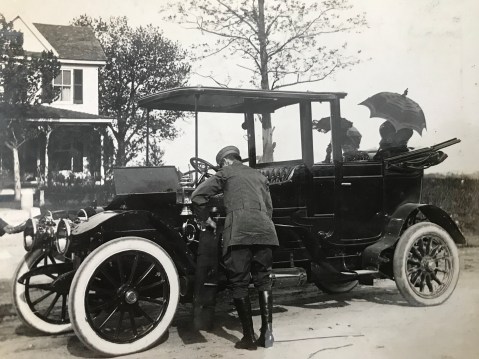
Two ladies with parasols are sitting in the landaulet section of an early Pierce-Arrow limousine, while chauffeur Lewis Reed tends to the motor. The rear portion of the limousine is partitioned from the driver with a glass shield, and covered by a convertible top, which you can see is currently in the lowered position behind the ladies. Ca. 1910

Chauffeur Lewis Reed (left) in the 1914 photo above poses with an unidentified family and their Pierce-Arrow Model 48.
Early automobiles were unreliable. They broke down frequently and needed to be pulled out of mud or snow by horses. They meant it back in the good old days when motorists were advised to “get a horse”. The photo shows William Beall in his 1915 Pullman in front of old St Mary’s Church and his younger brother Vernon on horseback “towing” him to Reed Brothers.
The touring car was one of the most common styles of automobile in the early decades of the 20th century. Nearly every auto manufacturer offered a vehicle in this style. Touring cars generally were denoted by an open body seating four or more people. Identified by the triangle logo on the grill and the number of passengers seated in it, the car below appears to be a 1918 Hudson Super Six Seven Passenger Touring. The Hudson and Oldsmobile were sold at Reed Brothers from roughly 1917 through 1923.
Vehicles required much higher road clearances than modern cars due to the poor state of roads and tracks, hence the large diameter skinny tires of the day which were effective at cutting through mud to reach more solid ground.

Early touring car with its top down. The folded top behind passengers was known as the “fan” when in the down position. Photo by Lewis Reed
The popularity of the touring car began to wane in the 1920s when cars with enclosed passenger compartments (i.e. fixed steel roofs) became more affordable, and began to consistently out-sell the open cars.
The touring car body style was popular in the early 20th century, being a larger alternative to the two-seat roadster. The photo below was taken in 1915 by Lewis Reed in front of the original Rockville Garage. Old St Mary’s Church is in the background. Note the unpaved dirt road on Veirs Mill Road. Rockville Garage was a distributor of Fisk Tires until circa 1918, when they replaced it with the Firestone brand. The car appears to be a 1916 Studebaker Roadster. The roadster was a sportier style of vehicle, usually a two-seater with a convertible canopy roof. Many manufacturers offered roadster versions of their larger touring car models.

This photo was taken by Lewis Reed across from Reed Brothers Dodge, circa 1915. Old St Mary’s Church is in the background. Photo by Lewis Reed.
Ever want to see how sausage is made? Well, okay – maybe not… but this interesting photo taken by Lewis Reed some 100 plus years ago allows you to see how 18 men managed to cram themselves into a 1910-1911 Pierce Arrow Model 48 7-Passenger Touring. Pierce-Arrow Motor Car Company in Buffalo, New York, produced some of the finest automobiles made and was one of the most popular high-quality cars of the time.
The automobile has affected this country more than any other invention of its time. Without automobiles, life as we know it would not be the same, and the changes that they have brought can be seen in every aspect of our lives.
Lewis Reed Captures the Thrill of Motorcycle Racing in 1915

A motorcycle racer rips down an unknown racetrack kicking up dust in his wake. Photo by Lewis Reed, ca. 1915
In the first years of the twentieth century, companies like Harley-Davidson and Indian began producing motorcycles for the general public. Although there is not an exact date of the first motorcycle race, you can be sure that as soon as there were two motorcycles on the road, there was racing. As more and more motorcycle manufactures started popping up across the U.S., motorcycle racing started making it’s way to more official venues. The earliest races were held on fairground dirt tracks used for horse racing.
This photograph taken by Lewis Reed shows an unknown racer at a fairground raceway in the early 1900s. In the teens, motorcycle racing on dirt tracks throughout the country, was one of the most popular spectator sports. Despite the danger to both racers and spectators, the motorcycle races became very popular and drew large crowds of spectators. Motorcycle racing continued until just after World War 1, when the focus shifted to automobile racing.
How Old Cars Were Heated
Nobody really thinks about it today. If your car is too cold, then simply switch on the “heater” and soon your car will be warm. However, it wasn’t always that way. What passengers did back then, in the early days of motoring, was bundle up as if one was outdoors. This meant heavy clothing, winter gloves and snow boots. It wasn’t long, however, before car makers realized that a few comforts, like heat in the passenger compartment, or even some type of heated seating, would help sell cars.
In order for occupants of early 1920’s cars to remain warm during the cold winter months, especially when it was snowing, it was necessary for them to dress warmly and cover themselves with blankets. Note the car in the photo below is mostly open-bodied, with no windows and certainly no heat. Tire chains are on the rear tires. I cannot say with any certainty, but I believe it is Lewis Reed’s car with his wife and baby daughter, Mary Jane, sitting inside all bundled up.
While this had been the accepted way to do things for centuries, it did not take long for automotive engineers to realize that heat from the car engine could also be used to warm the interior of the vehicle. Heaters became standard equipment on the more expensive cars and over time they were fitted to most cars. You could buy and fit after market car heaters to suit cheaper cars like the Fords and Chevrolets.
Below are some advertisements from an Automotive magazine of 1922 that show the two different ways motorists used to keep warm – the rug and the heater.
LAIDLAW MOTOR ROBES
An essential appointment in your own car. A seasonable gift for a friend.
BEAUTIFUL AND COMFORTABLE
You have your car insured against every possible contingency of accident, fire, theft, etc.,—but how about its occupants– can you guarantee their comfort against winter’s storm and cold?
LAIDLAW MOTOR ROBES are COLD INSURANCE, you pay no premiums on their price, yet you receive protection of warmth, comfort and luxury.
LAIDLAW MOTOR ROBES are made in an infinite variety of color and fabric, lined or not, as you wish. Monogrammed at but slight additional cost. Prices exceptionally low. Quality exceptionally high. Order now for holiday gifts.
Comfortable Driving at Zero!
THE KINGSTON CAR HEATER stands between you and the coldest wind that blows. It is a heater that keeps your car warm at zero weather, that warms the car with pure, fresh air, that can be instantly adjusted to meet your wants, that is beautifully and substantially built — an ornament to any car.
Note the new low price
DEALERS everywhere should order their stock of Kingston Heaters at once. Last year when cold weather came the demand was so great that some orders were delayed. This year, with greatly increased production, with a finer heater, and with the new low price the sales of Kingston Heaters will break all records.
FORD Model Complete $3.75
Chevrolet, Overland, Dodge $5.00



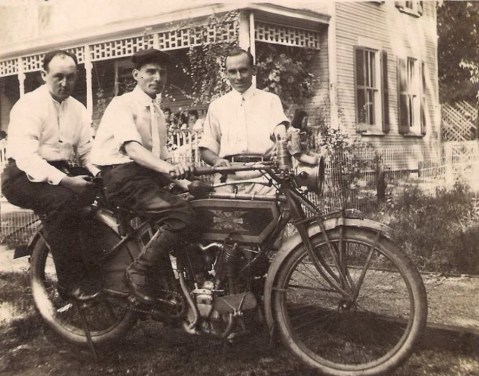



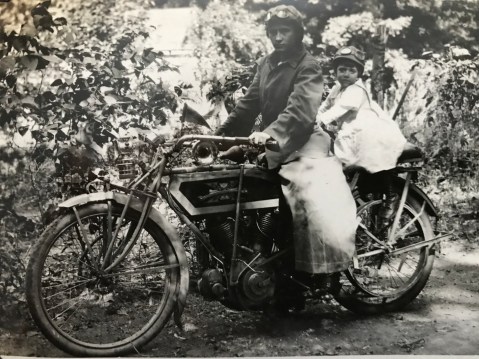






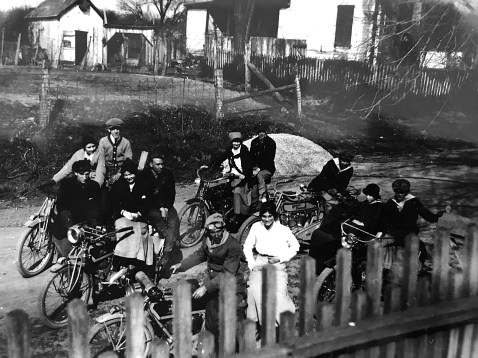

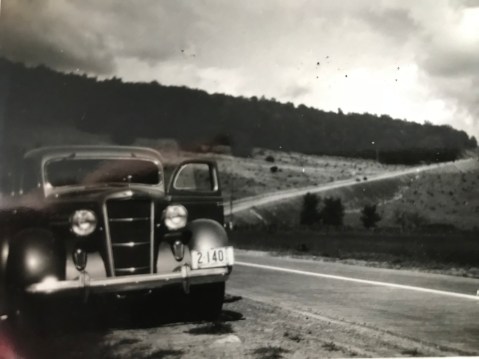
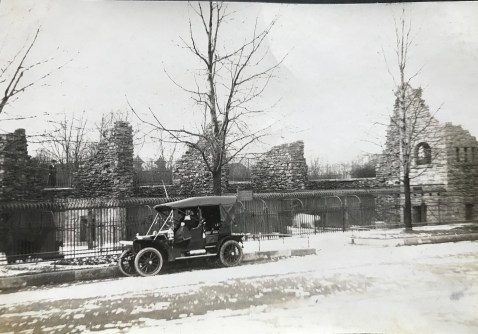


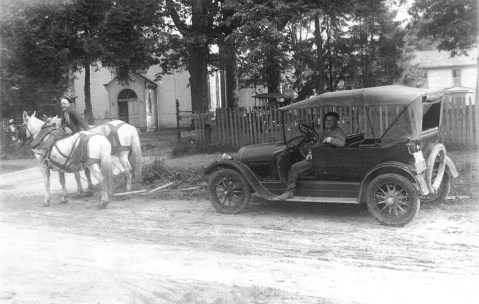
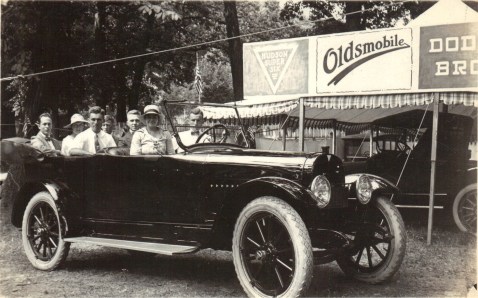
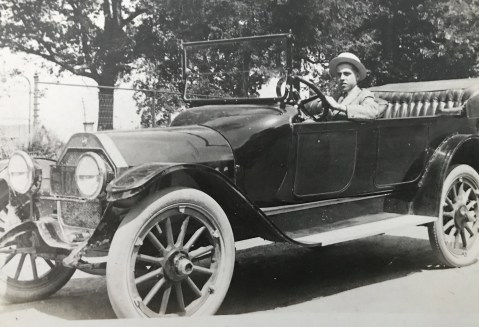














Recent Comments